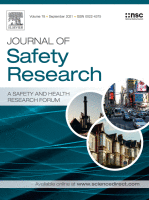On Research: Can training change teens’ attitudes about working safely?

Before young people enter the workforce, “we believe it’s important (they) be equipped with a foundation of work safety and health competencies on which job-specific safety training and skills can be built,” NIOSH’s Rebecca Guerin says.
Guerin is associate director for science of the agency’s Western States Division.
She recently co-authored, Evaluation of changes in knowledge and attitude among youth after a one-hour introduction to workplace safety and health: Safety Matters.
Guerin spoke with Safety+Health about the study, published in Volume 89 of the National Safety Council’s Journal of Safety Research. The following is an edited transcript.
What’s your study about?
Although we know that work provides many benefits such as the opportunity to gain independence, earn money and learn valuable life skills, young people often enter the labor force unprepared for the hazards they may encounter. We wanted to address this gap, so NIOSH and the American Industrial Hygiene Association worked together and developed Safety Matters. It’s a program geared toward high school-aged youth, with the goal to create a free, simple-to-use educational module that can be delivered by AIHA members and their communities. Safety Matters provides an overview of essential workplace safety and health information, which serves as a foundation on which future job-specific safety training can be built. The module also includes information on careers in occupational safety and health. In terms of the study itself, Safety Matters was evaluated in 2019 by our partner at the Colorado Department of Public Health and Environment. Results from these assessments demonstrate the effectiveness of Safety Matters to increase work-related health and safety knowledge and change attitudes about the importance of occupational safety and health.
What drove your interest in this topic?
For many years … young worker safety and health has been a priority focus area for research and outreach at our institute. This is because young workers in the United States experience persistent occupational health inequities. About once every five minutes, a worker aged 15-19 in the United States is injured at work seriously enough to require an ER visit. We know from research that work-related injuries can have lifelong consequences and devastating impacts on young workers and their families. Employers are responsible by law for maintaining safe and healthy workplaces and delivering job-related safety training.
What, if anything, surprised you about the results?
Young people receiving instruction on workplace safety and health with Safety Matters demonstrated significant increases in workplace safety and health knowledge and attitude scores across all ages, sexes, races, ethnicities and previous work experience groups. This is really a nice surprise because there’s limited research demonstrating the effectiveness of one-hour health promotion programs to increase knowledge or change health- or safety-related attitudes, especially among youth.
How should occupational safety messages be communicated to young workers?
It’s important for employers to create a workplace culture that encourages young workers to ask questions about health and safety concerns and to avoid making assumptions about what young workers know, even if something seems obvious. Young people may be embarrassed about or uncomfortable asking questions. It’s also important for employers to provide safety training using words teens can understand, pointing out safety precautions and workplace hazards; giving clear instruction for each task, especially unfamiliar ones; providing hands-on training on correct use of equipment; and constantly reinforcing this training.
Post a comment to this article
Safety+Health welcomes comments that promote respectful dialogue. Please stay on topic. Comments that contain personal attacks, profanity or abusive language – or those aggressively promoting products or services – will be removed. We reserve the right to determine which comments violate our comment policy. (Anonymous comments are welcome; merely skip the “name” field in the comment box. An email address is required but will not be included with your comment.)


